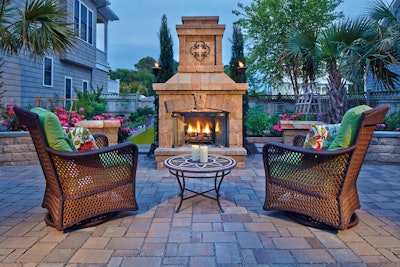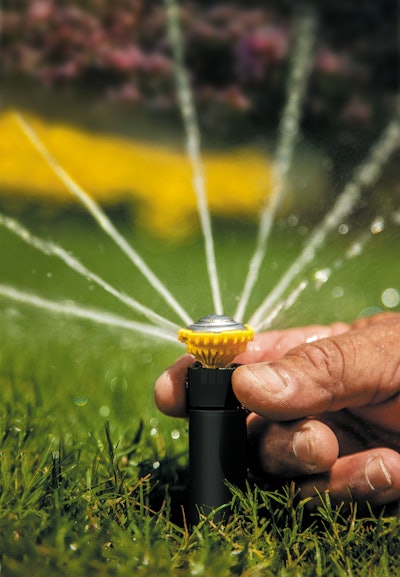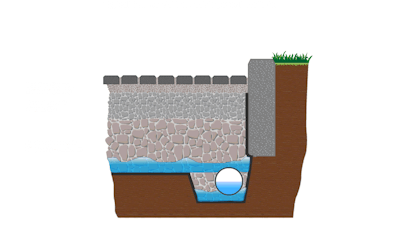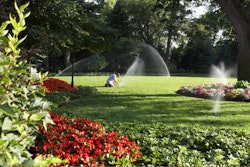 Photo: Belgard
Photo: Belgard
“Droughts and water regulations often drive the irrigation industry to provide more training and develop new products/technologies that support water conservation,” says Jessica Case, product manager for Rain Bird Corporation. “I think the increased focus on conservation and available resources encourage customers to try new things.”
Whether your customers are just wanting to lower their monthly water bills or genuinely want to cut back on water wastage, here are some different water conservation options you can work into the landscape.
Methods for conserving water
According to Mitch Heiner, national irrigation product manager for Ewing Irrigation and Landscape Supply, a majority of the new irrigation technology comes from the golf industry and trickles into commercial and residential applications as the technology becomes cost efficient to produce. Because of the continual improvements, it’s important to stay up to date with what’s new on the market.
 Photo: Rain Bird Corporation
Photo: Rain Bird Corporation“One of the best ways to conserve water with irrigation systems is to stay informed,” Case says. “Some innovations, like pressure regulation, have been on the market for 20+ years. Other technologies, like smart controllers, are constantly evolving. Regularly take classes and attend irrigation shows to see what’s out there.”
Take the time to educate customers who might want to make improvements but are afraid they’ll have to make a huge investment that there are a considerable amount of small changes they can opt for that will still make a difference.
“Sometimes customers think they have to upgrade their entire irrigation system to smart devices to see any results,” Case says. “While this is a best practice to maximize water and energy efficiency, you can realize substantial savings with small changes over time. For example, with pressure regulating spray heads and nozzles, any reduction in pressure towards 30 psi saves water and increases the system performance.”
Aside from simply having an efficient irrigation system, talk to customers about replacing plants with high water needs with less water dependent varieties. It’s also a good rule of thumb to practice hydrozoning by grouping plants with similar water requirements together.
Another practice that can help with water conservation is installing permeable hardscaping when possible. Permeable pavers utilize highly permeable aggregate as a base and in between the paving units to filter and store rainwater, eliminating most surface runoff.
“One hundred percent of the water that hits a surface with a traditional pavement will run off into some form of drainage system, such as a storm drain, retention pond and ultimately into a local stream or river,” says Kevin Earley, director, Commercial Belgard Pavers. “With traditional pavements (asphalt and concrete or non-permeable pavers), water runs off these materials and, in turn, does not directly replenish the supply of ground water. Instead, polluted water flows into lakes and rivers from streets and sewers. With permeable pavers and surfaces, almost 100 percent of the water will filter through the pavers themselves into the substrate, allowing the water to eventually seep back into the local aquifer.”
 Graphic: Belgard
Graphic: BelgardBecause the water can percolate through to replenish groundwater, commercial projects are able to develop land that originally would be allocated to retention ponds and water collection areas as required by government regulations.
“Permeable pavers are an excellent choice for water conservation,” Earley says. “Allowing rain water to drain through pavement prevents runoff and allows for water to recharge the underlying aquifer. The distributive nature of introducing rainwater through infiltration is why permeable pavers are considered Low Impact Design (LID) and are considered Green Infrastructure by most stormwater regulatory agencies.”
Earley adds that permeable surfaces are especially beneficial in areas with sensitive waterways, such as Philadelphia and the Chesapeake Bay area.
“Over time, bacteria grow within the aggregate below permeable pavement,” he says. “These bacteria breakdown materials, like oil and gas, as well as harmful toxins as water percolates through the permeable surface. This process filters the groundwater so that the aquifer is restocked with clean, clarified water. Permeable pavement allows for water to be treated and clarified of nonpoint pollution and toxins that would otherwise be almost impossible to treat.”
Worst practices
While those are some of the possibly overlooked options when it comes to water conservation, there are also some worst practices that landscapers need to avoid.
 This water is able to reach the groundwater thanks to permeable pavers.
This water is able to reach the groundwater thanks to permeable pavers.Photo: Belgard
“The opposite of smart irrigation best practices is taking no action to conserve water because you don’t think one irrigation zone, or home, or park can make a difference,” Case says. “Every small change can lead to another, and before you know it you’ve made a significant impact.”
Aaron Knepp, owner of a Conserva Irrigation franchise in Columbus, Ohio, says a major mistake is failing to look at the irrigation system’s design before adding efficiency upgrades. He says he always looks at the infrastructure and ensures there aren’t any flaws or troubled areas before installing a Wi-Fi control panel.
Heiner adds that another bad practice is “using a traditional ‘dumb’ controller on a system with too much pressure that runs a zone for way longer than necessary, only to lose most of the atomized water droplets to the wind carrying it somewhere else other than where it was intended to delivered.”
For more information of proper irrigation design, installation, maintenance and auditing, check out the Irrigation Association’s technical resources page.











